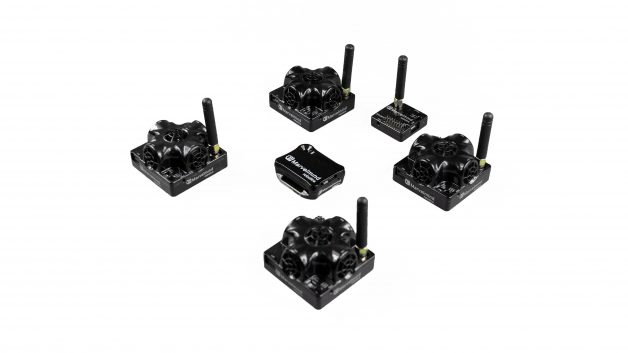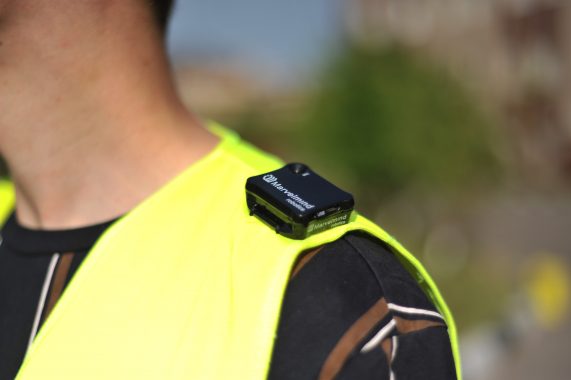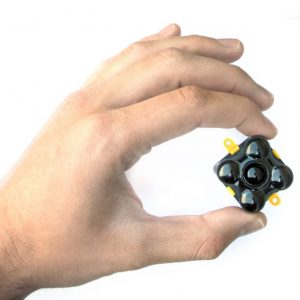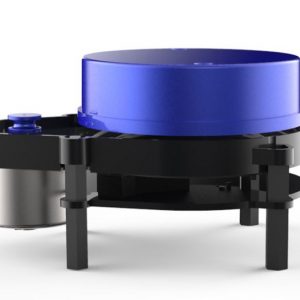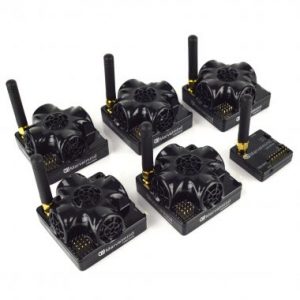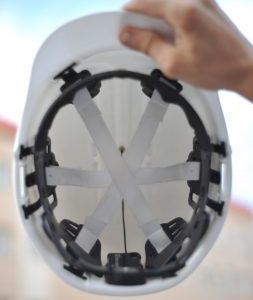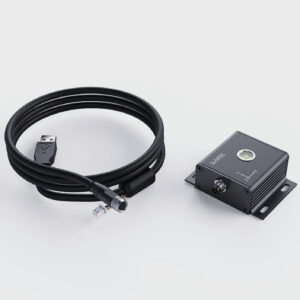Description
商品說明 :
- IA (Inverse Architecture)
- Stationary beacons(固定點) 彼此的發射頻率須是不相同的 (頻率選擇包括19, 25, 31, 37, 45 kHz)
- 位置更新速度與mobile beacons (移動點)的數量沒有直接關係
- 移動點安裝在較吵的機器人環境上,固定點beacons安裝在相對安靜的場所
- 安裝在移動的人或機器上,通訊透過 virtual COM (USB port)
- Indoor localization 系統最低組成需要 2個(或以上)固定點 + 1個(或以上)Mini-Rx Beacons + 1個中央路由器
- 最多可用250個beacons,每個beacons涵蓋範圍 30 ~ 50 米
- 可應用在不同區域與不同地圖的建置
- 價格便宜安裝迅速的機器人定位方法
- NIA (Non-Inverse Architecture)
- Stationary beacons(固定點) 彼此的發射頻率須是相同的
- 位置更新速度與mobile beacons (移動點)的數量有關係 (25Hz更新速度)
- 移動點安裝在較安靜的機器或人環境上,固定點beacons安裝在相對較吵的場所
- 安裝在移動的人或機器上,通訊透過 SPI, I2C, USB
- Indoor localization 系統最低組成需要 2個(或以上)固定點 + 1個(或以上)Mini-Rx Beacons + 1個中央路由器
- 最多可用250個beacons,每個beacons涵蓋範圍 30 ~ 50 米
- 可應用在不同區域與不同地圖的建置
- 價格便宜安裝迅速的機器人定位方法
- 還是看不懂,正常 ! 沒關係,看一下這裡,更詳細扼要地介紹IA , NIA, MF NIA 的架構與比較
- 所謂的3D就是 (x,y,z)立體空間的定位,2D就是(x,y)平面的定位測量。簡單說,只要一個(or以上) beacon放在Z軸方向上,就可形成3D定位。
- 各種應用介紹 (工廠與作業場所安全,定位系統,建築工地安全、隧道安全與人員定位,智慧安全防護帽/智慧安全背心/智慧徽章/搬運機器人),下載這個25頁的投影片
- 2D / 3D 定位,mobile beacons 移動點與stationary beacons 固定點的擺設方法,參考這裡
- 看一下這裡,更詳細扼要地介紹IA , NIA, MF NIA 的架構與比較
- 無人機/Pixhawk 與 marvelmind的架設安裝方法,參考這裡
- 室內定位詳細手冊與理論,參考這裡
- 所有軟體都免費,參考這裡
- Live demo: Delivering boxes on a car assembly plant
- Live demo: Delivering boxes on a car assembly plant – system view
- Live demo: Don’t-Try-This-At-Home fun edition 😉
內容物 :
- 4 Stationary beacons with standard 50mm antennas
- 1 Mobile beacon without IMU
- 1 Modem supporting up to 250 beacons
The Starter Set IA-02-3D
This is a Starter Set supporting Inverse Architecture (IA) with 3D tracking (XYZ).
All essential SW as well as Marvelmind Dashboard API are already included in the price. Just download the Marvelmind SW pack: https://marvelmind.com/download/ => https://marvelmind.com/pics/marvelmind_SW.zip.
In the Inverse Architecture (IA), stationary beacons emit ultrasound and mobile beacons receive it. Thus, it is possible to have multiple mobile beacons without update rate reduction per mobile beacon, unlike in the Non-Inverse Architecture (NIA). See more in the Architecture Comparison.
Content:
- 1 x Beacons Mini-RX 915/868 MHz as mobile beacon
- 4 x Beacon HW v4.9 915/868 MHz with different ultrasonic frequencies (19kHz, 25kHz, 31kHz, 37kHz, 45kHz) as stationary beacons
- 1 x Modem HW v4.9 915/868 MHz as central controller of the system
The HW of the system supports two bands:
- License-free ISM band (915 MHz) for the US and countries in Region 2 (https://en.wikipedia.org/wiki/ITU_Region)
- License-free SRD band (868 MHz) for the EU and other countries: (https://en.wikipedia.org/wiki/Short-range_device#SRD860)
We always recommend to check your country’s local regulations.
Use cases:
- One person or autonomous robot or forklift or another object. Covered area of up to 1,000 m2
- Especially good for tracking people. See demos:
- Tracking four warehouse workers. Configuration: 4 x Beacons Mini-RX + 2 x Beacons HW v4.9 + 1 x Modem HW v4.9
- Tracking one person with three mobile beacons
- Measuring iPhone with the help of Precise Indoor “GPS”. Configuration: 1 x Beacons Mini-RX + 2 x Beacons HW v4.9 + 1 x Modem HW v4.9
The Inverse Architecture is not well suitable for drones, especially, for larger and noisier ones without special methods to shield the mobile beacons for noise from rotors, because mobile beacon is receiving ultrasound in this architecture. If placed on the drone, the drone’s rotor’s noise would limit the ultrasonic range quite much. Starter Sets with NIA are designed for that kind application, for example, Starter Set NIA-02. However, in special cases, particularly, with mini- and micro-drones and special ultrasonic shield, IA works very well
Further expansion:
- For more mobile objects – add more mobile beacons Mini-RX
- For more coverage – add more stationary beacons and build submaps. Notice, that building submaps in IA requires more skills and understanding of the IA architecture, than in NIA. It is much easier in NIA, because only one ultrasonic frequency is used in NIA
The Mini-RX beacons – the mobile beacons of this set – differ from regular Beacons HW v4.9 in several ways:
- The Mini-RX an RX-only beacon, i.e. it can receive, but it cannot transmit ultrasonic signal. The fact that it is an RX-only makes it more sensitive, i.e. you will get a longer range between Beacon HW v4.9 and the Mini-RX than between Beacon HW v4.9 and Beacon HW v4.9
- The Mini-RX beacons can receive any ultrasonic frequency from the bands: 19kHz, 25kHz, 31kHz, 37kHz, 45kHz. The filter can be simply selected in the Dashboard. At the same time, the working ultrasonic frequency of Beacon HW v4.9 is HW-defined by ultrasonic sensors and can’t be changed
- The Mini-RX beacons can receive several ultrasonic frequencies at once. That is used in Inverse Architecture. See the comparison
- The Mini-RX beacons are significantly smaller, than Beacon HW v4.9. For more, check the Beacons Comparison table
- The Mini-RX beacons can work with regular Beacons HW v4.9 in any combination as a part of a Starter Set or as a part of navigation systems and it is a superior RX-only replacement to HW v4.9. At the same time, since it is RX-only beacon, while the Beacons HW v4.9 is a universal dual-use beacon
Marvelmind Indoor Navigation System is an off-the-shelf indoor navigation system designed to provide precise (±2cm) location data to autonomous robots, vehicles (AGV), drones and forklifts. It can also be used to track other objects that the mobile beacon is installed upon, for example, virtual reality (VR) systems, helmets for construction workers or miners, jackets, etc.
The navigation system is based on stationary ultrasonic beacons that are united by radio interface in a license-free band (915MHz). The location of the mobile beacon is calculated based on the propagation delay of an ultrasonic signal (Time-Of-Flight or TOF) to a set of stationary ultrasonic beacons using trilateration.
Key requirements for the system to function properly:
- For 3D (X, Y, Z) tracking – An unobstructed line of hearing/sight by a mobile beacon to three or more stationary beacons simultaneously
- For 2D (X, Y) tracking – An unobstructed line of hearing/sight by a mobile beacon to two or more stationary beacons simultaneously
- Distance to the nearest 2 or 3 beacons – not more than 30 meters (recommended). In ideal conditions – up to 50 meters
Content
- 1 x Beacons Mini-RX 915MHz as mobile beacon
- 2 x Beacon HW v4.9 915 MHz with different ultrasonic frequencies (f1 and f2) as stationary beacons
- 1 x Modem HW v4.9 915MHz as central controller of the system
Distance between beacons
- Reaches up to 50 meters in lab conditions
- Recommended distance in real-life environment – up to 30 meters (Transducer4 of Beacon HW v4.9 looking straight at Beacon Mini-RX)
Coverage area
- Reaches up to 1,000 m2
- Coverage for larger territories can be increased further with more stationary beacons (in future SW releases)
Location precision
- Absolute: 1–3% of the distance to the beacons
- Differential precision: ±2 cm
Location update rate
- 0.05–8Hz
- Can be set manually or in automatic mode
- Depends on the distance between the mobile and stationary beacons (shorter distance — higher update rate)
- Does not directly depend on the number of mobile beacons, unlike in Non-Inverse Architecture. All beacons have location update at the same time
- Depends on the radio interface profile (500kbps vs. 38kbps)
參考資料 :

